University Economics Report: Analysis of Indian Economic Indicators
VerifiedAdded on 2022/10/01
|13
|1080
|454
Report
AI Summary
This report presents an analysis of the Indian economy using macroeconomic data from 2014 to 2018, focusing on key indicators such as real GDP, GDP growth, per capita GDP, unemployment rate, inflation rate, and net exports. The study employs SPSS software for data handling, including the calculation of summary statistics and the generation of trend analyses through graphical representations. The report reveals an increasing trend in real GDP and per capita GDP, while the unemployment rate also shows an upward trend. The analysis also highlights fluctuating trends in inflation and GDP growth, along with a worsening trade balance. The report attributes the economic trends to factors like private consumption, investment, exports, and the slowdown in agriculture and manufacturing. Challenges such as unemployment, inflation, and trade deficits are also discussed, along with the impact of policy uncertainties.
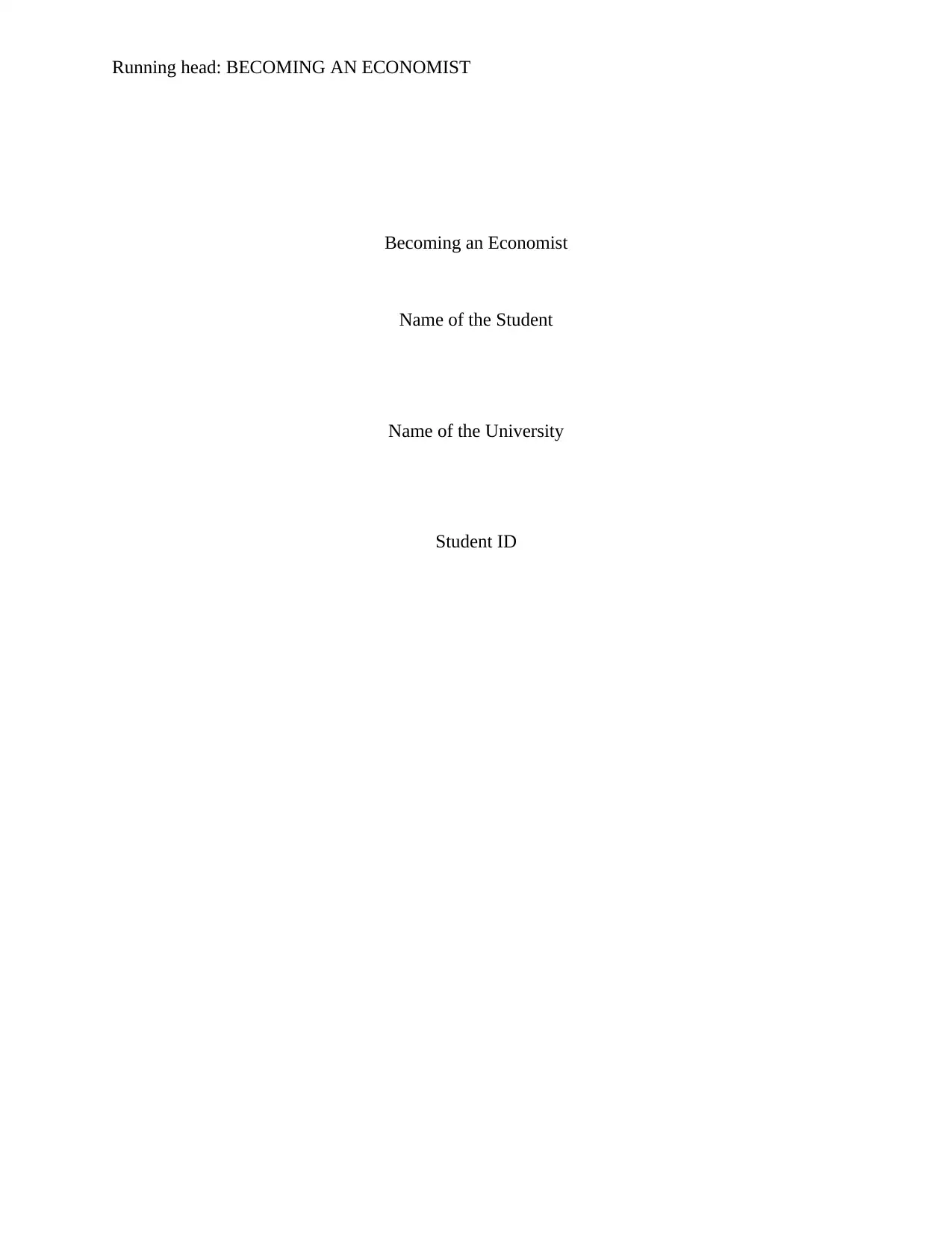
Running head: BECOMING AN ECONOMIST
Becoming an Economist
Name of the Student
Name of the University
Student ID
Becoming an Economist
Name of the Student
Name of the University
Student ID
Paraphrase This Document
Need a fresh take? Get an instant paraphrase of this document with our AI Paraphraser
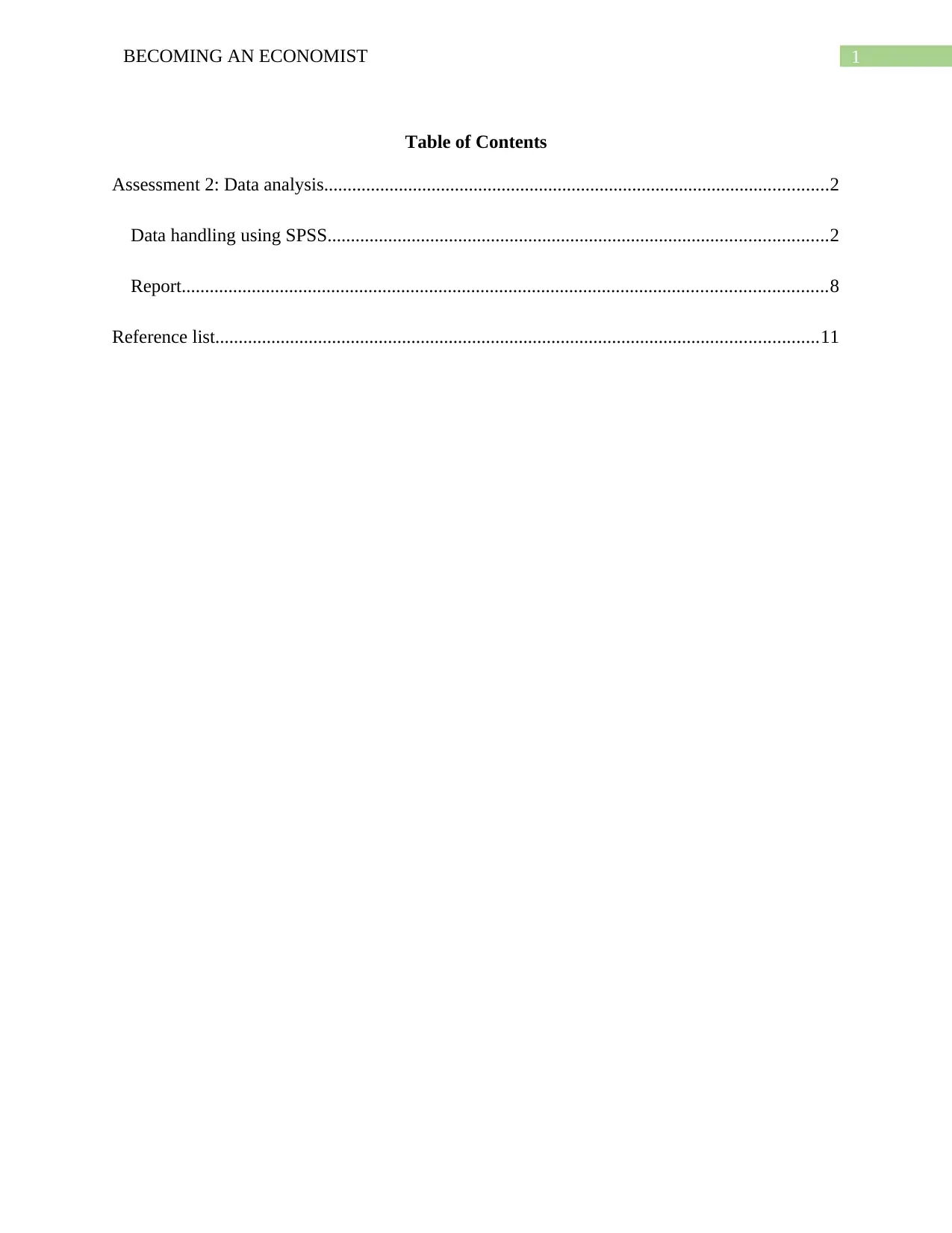
1BECOMING AN ECONOMIST
Table of Contents
Assessment 2: Data analysis............................................................................................................2
Data handling using SPSS...........................................................................................................2
Report..........................................................................................................................................8
Reference list.................................................................................................................................11
Table of Contents
Assessment 2: Data analysis............................................................................................................2
Data handling using SPSS...........................................................................................................2
Report..........................................................................................................................................8
Reference list.................................................................................................................................11
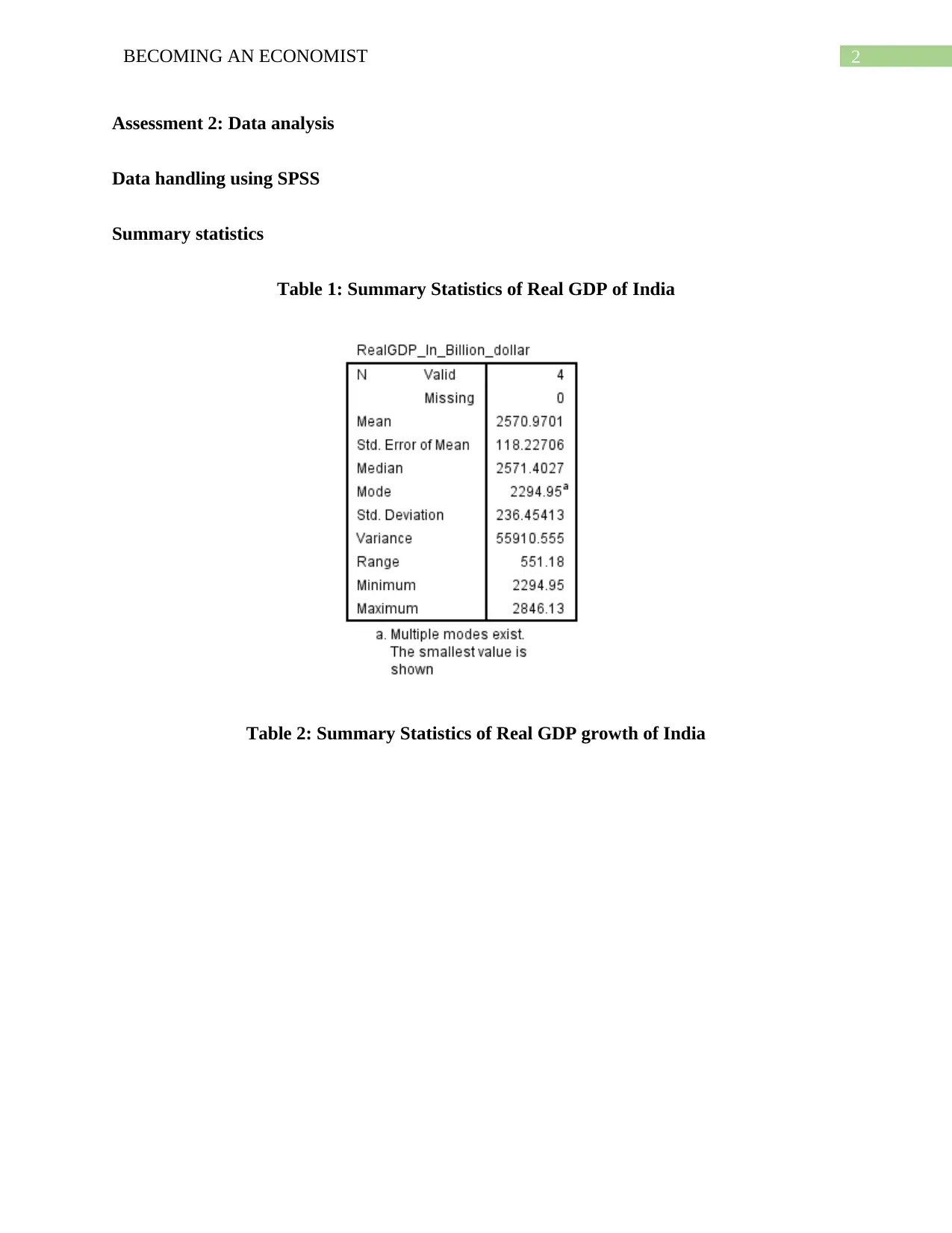
2BECOMING AN ECONOMIST
Assessment 2: Data analysis
Data handling using SPSS
Summary statistics
Table 1: Summary Statistics of Real GDP of India
Table 2: Summary Statistics of Real GDP growth of India
Assessment 2: Data analysis
Data handling using SPSS
Summary statistics
Table 1: Summary Statistics of Real GDP of India
Table 2: Summary Statistics of Real GDP growth of India
⊘ This is a preview!⊘
Do you want full access?
Subscribe today to unlock all pages.

Trusted by 1+ million students worldwide
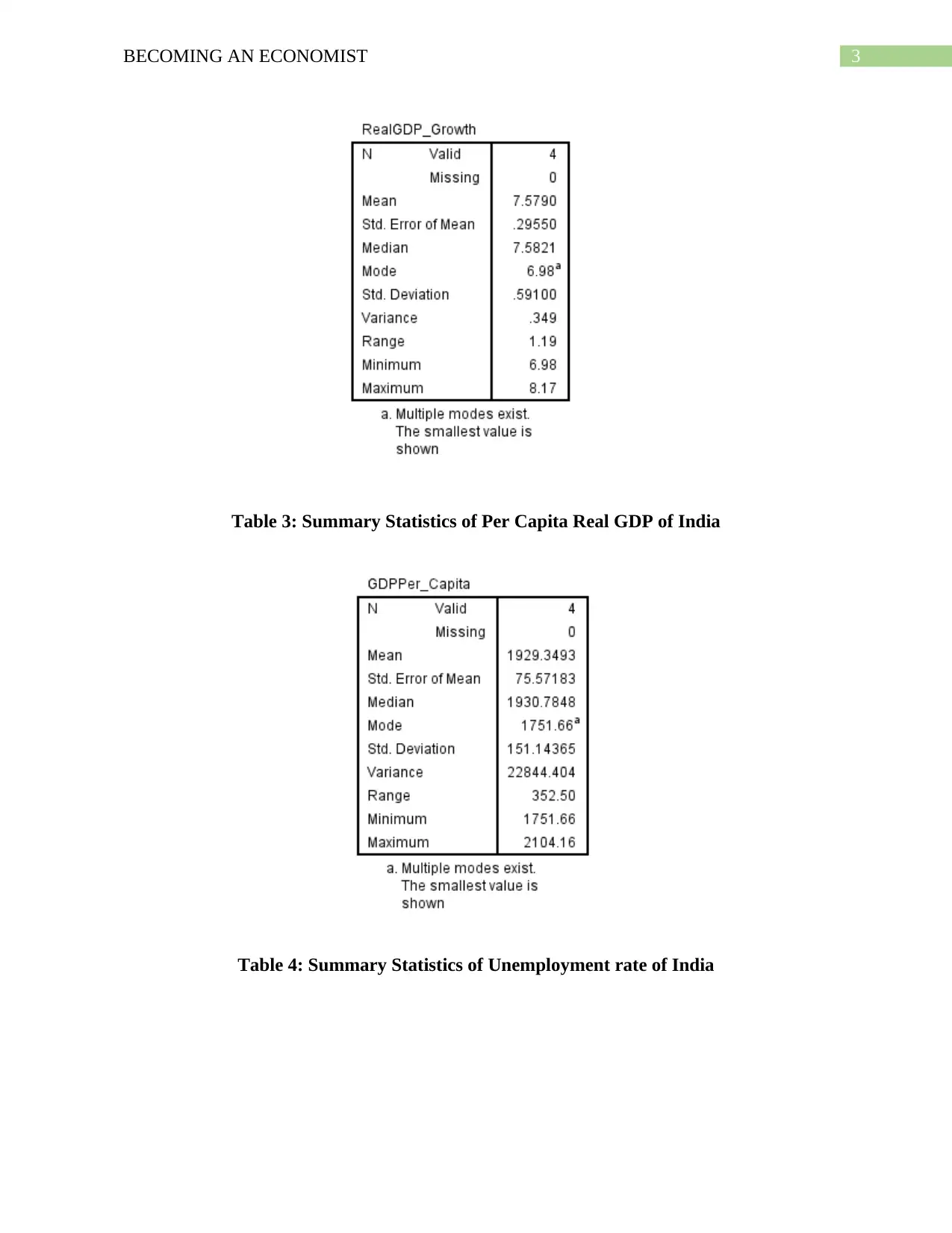
3BECOMING AN ECONOMIST
Table 3: Summary Statistics of Per Capita Real GDP of India
Table 4: Summary Statistics of Unemployment rate of India
Table 3: Summary Statistics of Per Capita Real GDP of India
Table 4: Summary Statistics of Unemployment rate of India
Paraphrase This Document
Need a fresh take? Get an instant paraphrase of this document with our AI Paraphraser
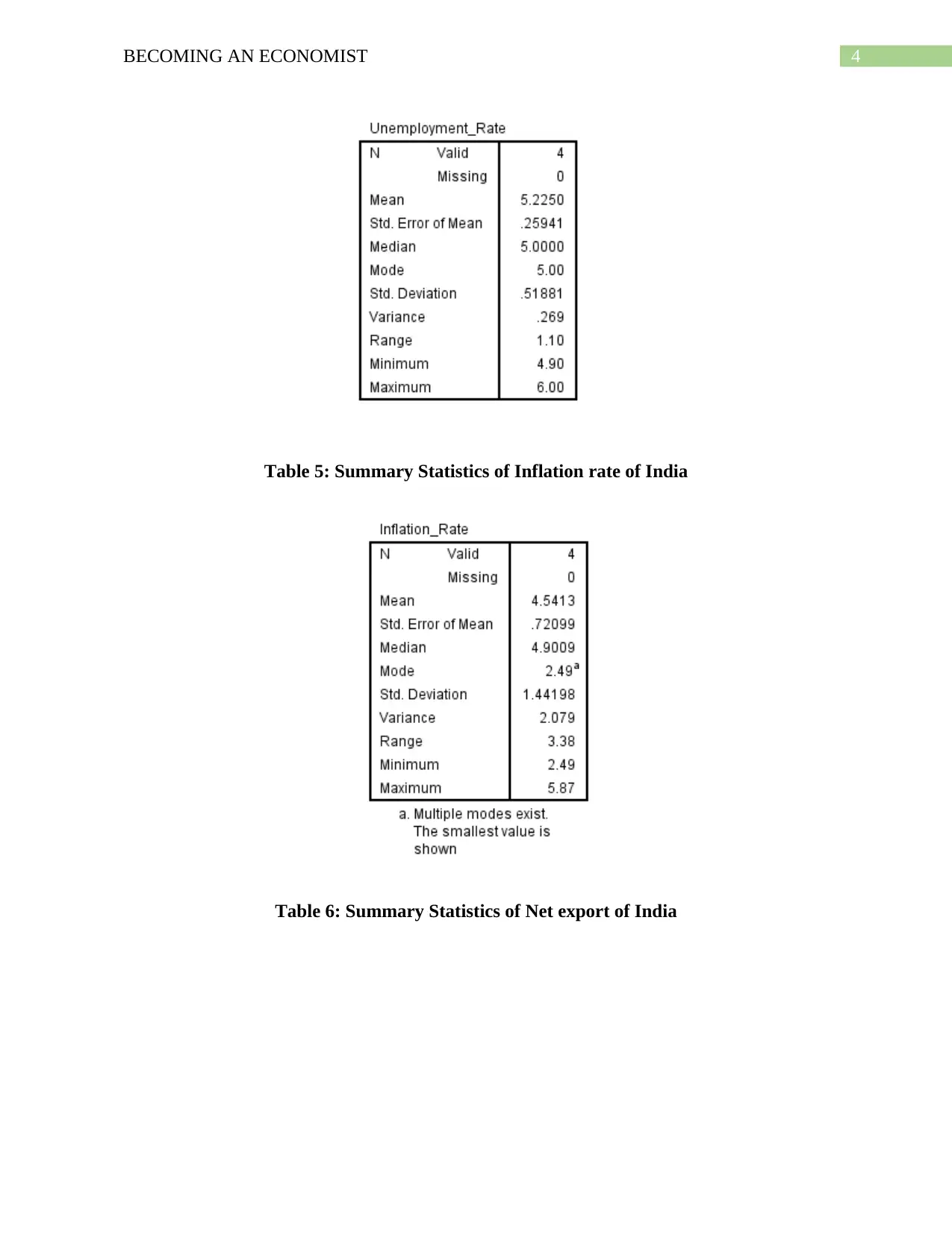
4BECOMING AN ECONOMIST
Table 5: Summary Statistics of Inflation rate of India
Table 6: Summary Statistics of Net export of India
Table 5: Summary Statistics of Inflation rate of India
Table 6: Summary Statistics of Net export of India
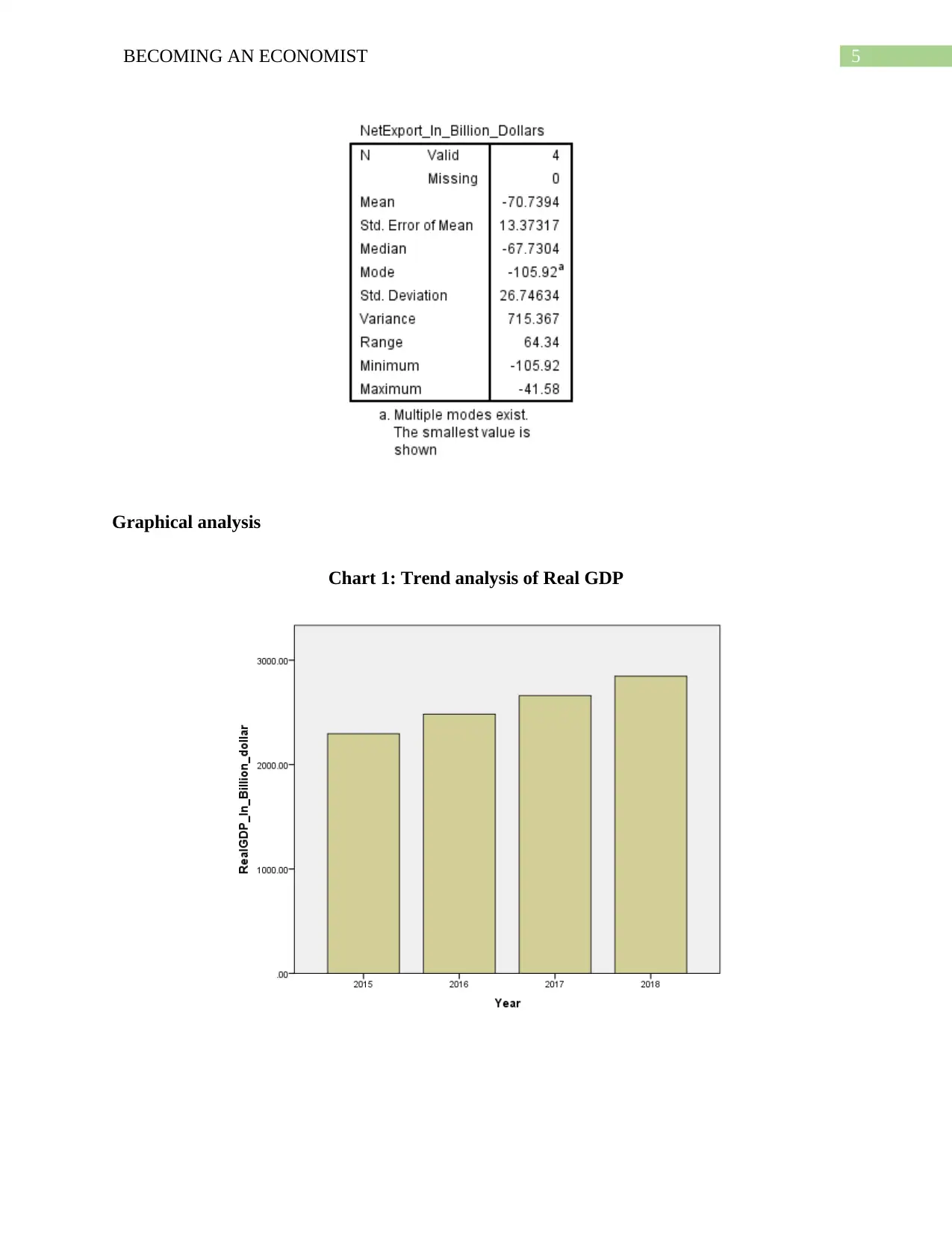
5BECOMING AN ECONOMIST
Graphical analysis
Chart 1: Trend analysis of Real GDP
Graphical analysis
Chart 1: Trend analysis of Real GDP
⊘ This is a preview!⊘
Do you want full access?
Subscribe today to unlock all pages.

Trusted by 1+ million students worldwide
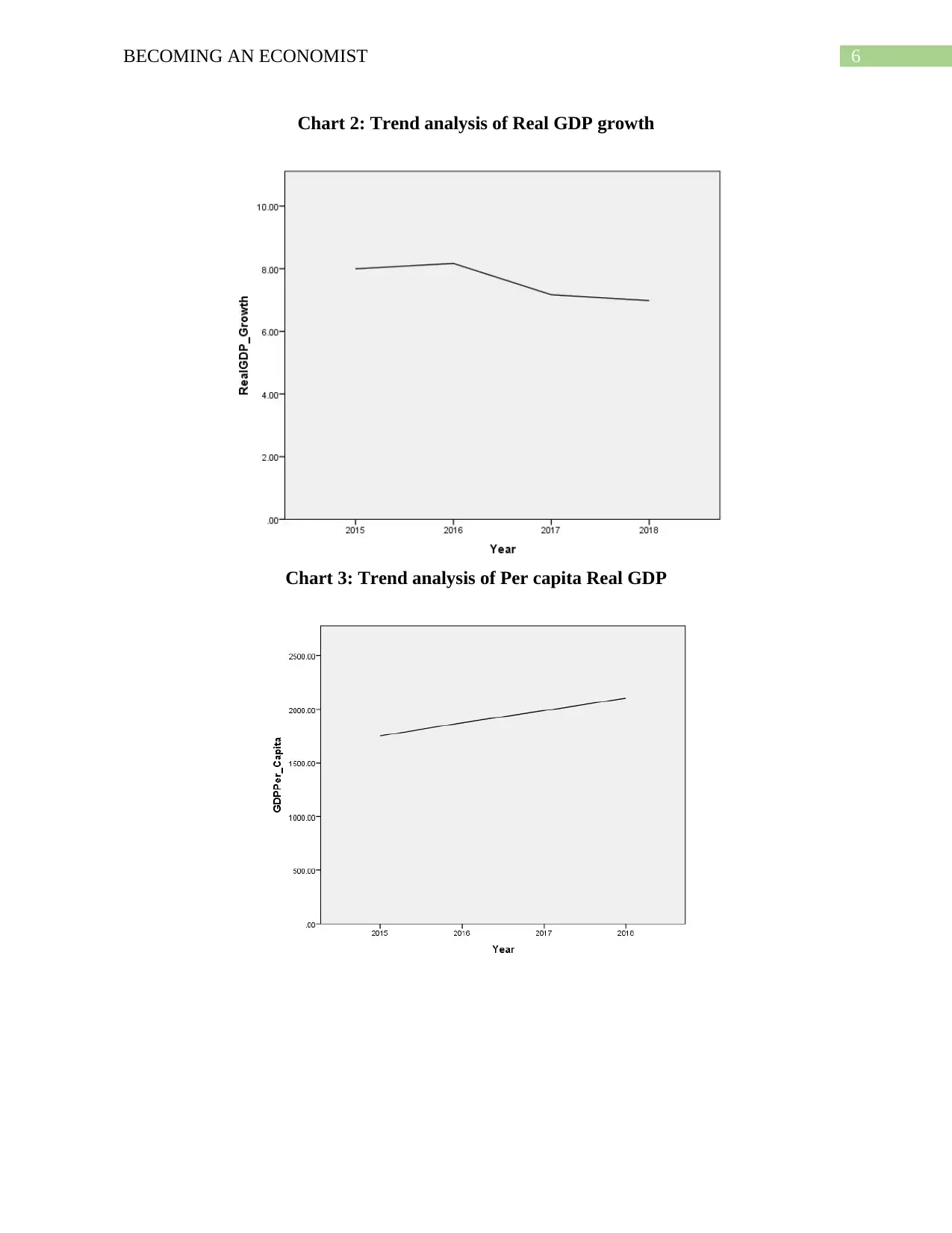
6BECOMING AN ECONOMIST
Chart 2: Trend analysis of Real GDP growth
Chart 3: Trend analysis of Per capita Real GDP
Chart 2: Trend analysis of Real GDP growth
Chart 3: Trend analysis of Per capita Real GDP
Paraphrase This Document
Need a fresh take? Get an instant paraphrase of this document with our AI Paraphraser
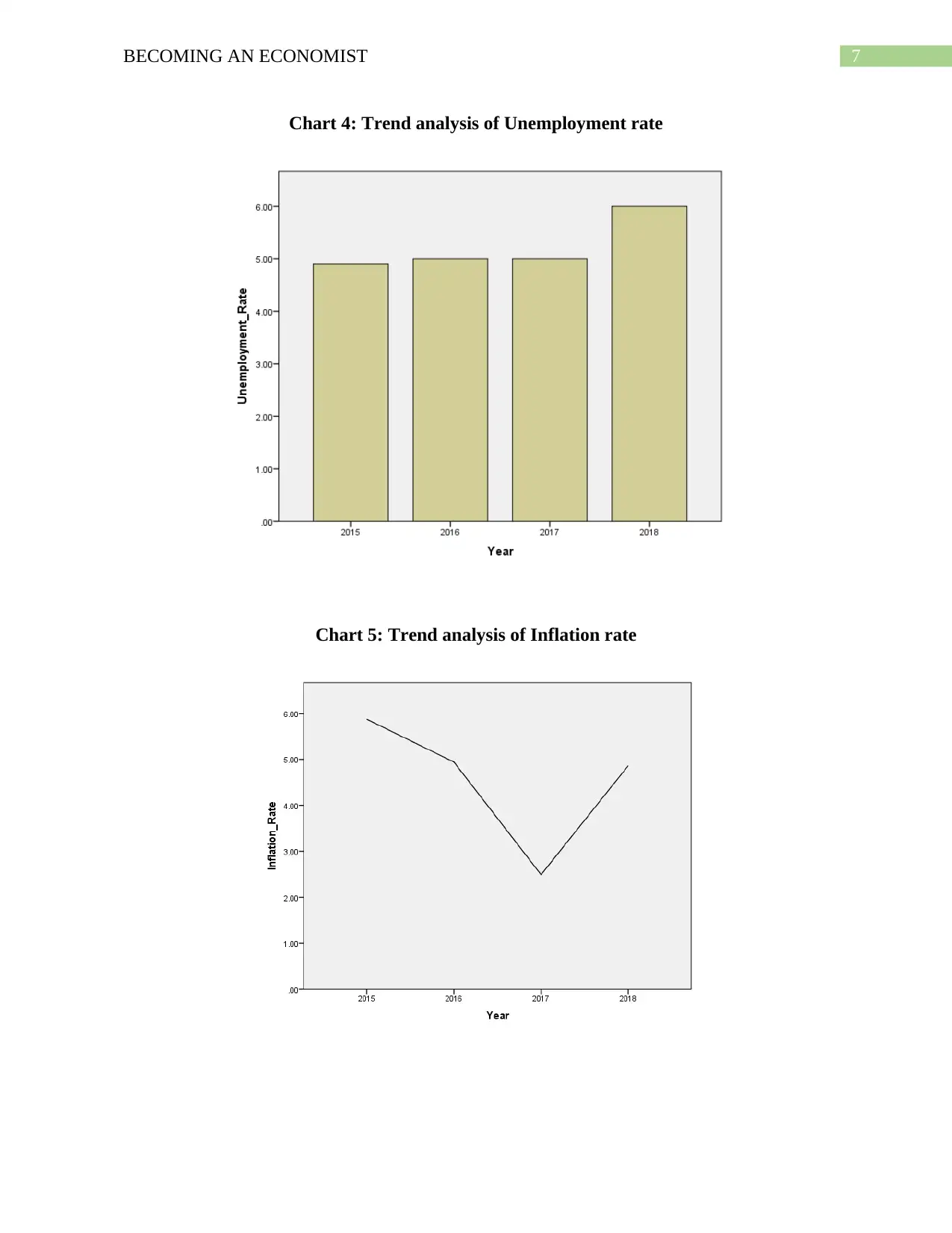
7BECOMING AN ECONOMIST
Chart 4: Trend analysis of Unemployment rate
Chart 5: Trend analysis of Inflation rate
Chart 4: Trend analysis of Unemployment rate
Chart 5: Trend analysis of Inflation rate
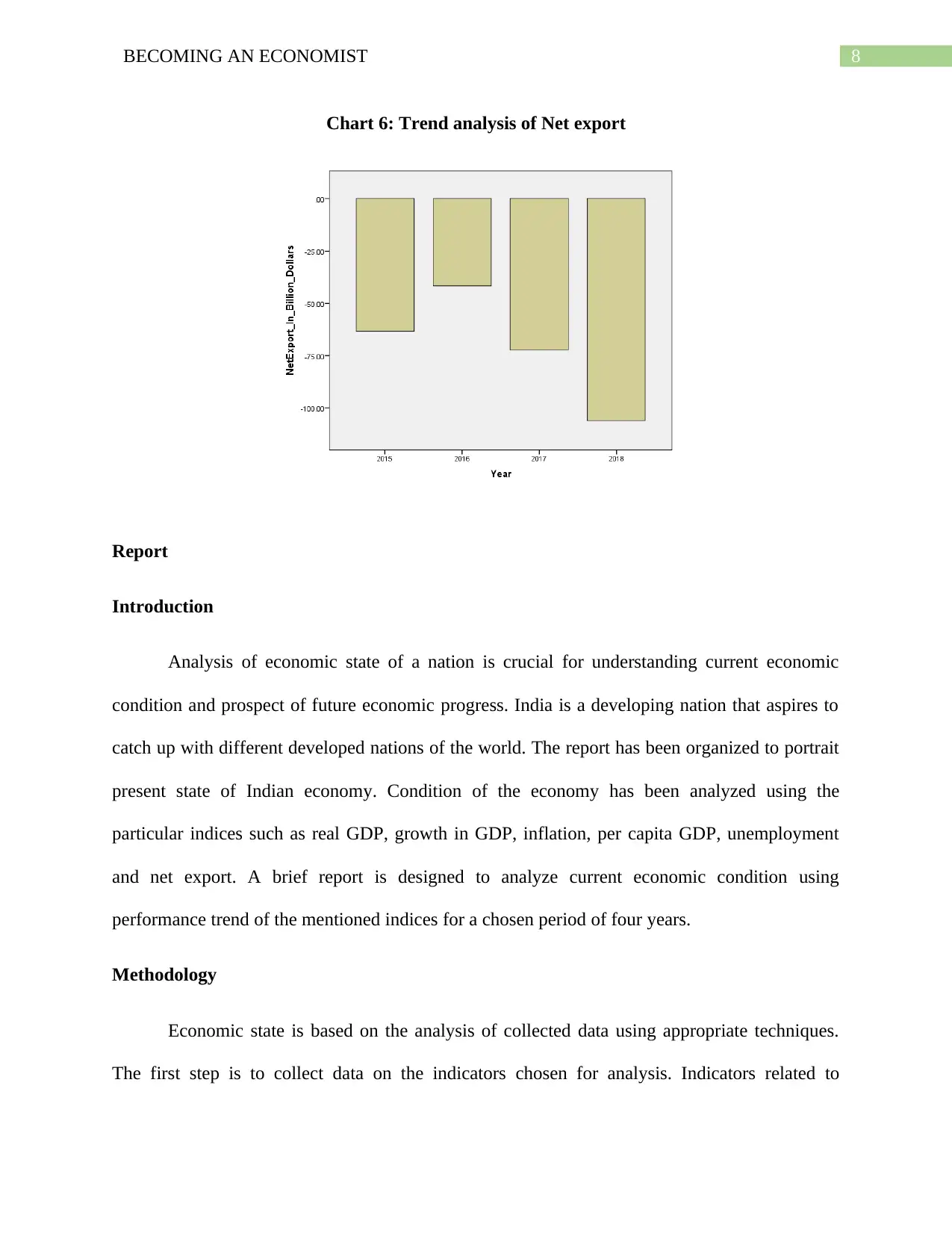
8BECOMING AN ECONOMIST
Chart 6: Trend analysis of Net export
Report
Introduction
Analysis of economic state of a nation is crucial for understanding current economic
condition and prospect of future economic progress. India is a developing nation that aspires to
catch up with different developed nations of the world. The report has been organized to portrait
present state of Indian economy. Condition of the economy has been analyzed using the
particular indices such as real GDP, growth in GDP, inflation, per capita GDP, unemployment
and net export. A brief report is designed to analyze current economic condition using
performance trend of the mentioned indices for a chosen period of four years.
Methodology
Economic state is based on the analysis of collected data using appropriate techniques.
The first step is to collect data on the indicators chosen for analysis. Indicators related to
Chart 6: Trend analysis of Net export
Report
Introduction
Analysis of economic state of a nation is crucial for understanding current economic
condition and prospect of future economic progress. India is a developing nation that aspires to
catch up with different developed nations of the world. The report has been organized to portrait
present state of Indian economy. Condition of the economy has been analyzed using the
particular indices such as real GDP, growth in GDP, inflation, per capita GDP, unemployment
and net export. A brief report is designed to analyze current economic condition using
performance trend of the mentioned indices for a chosen period of four years.
Methodology
Economic state is based on the analysis of collected data using appropriate techniques.
The first step is to collect data on the indicators chosen for analysis. Indicators related to
⊘ This is a preview!⊘
Do you want full access?
Subscribe today to unlock all pages.

Trusted by 1+ million students worldwide
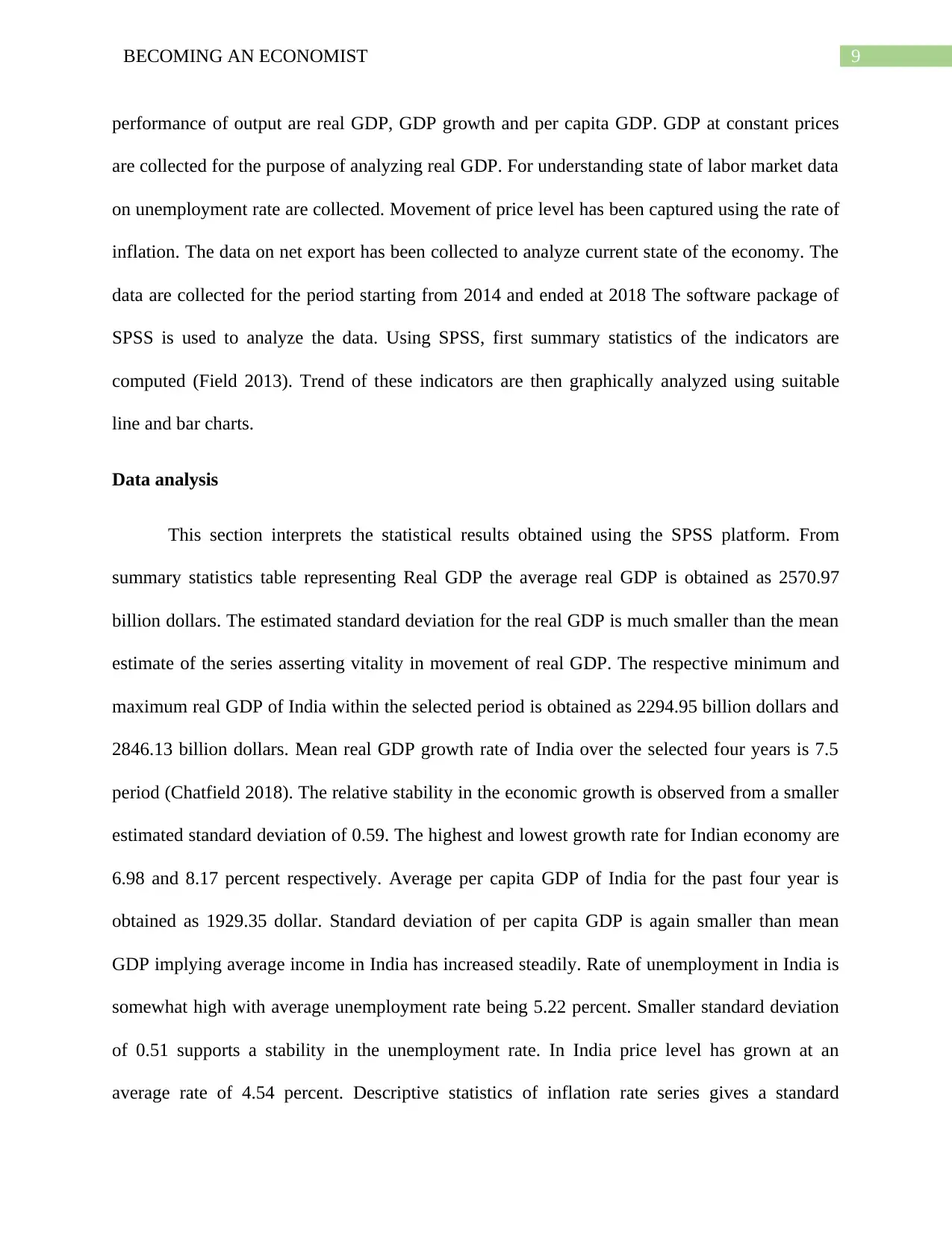
9BECOMING AN ECONOMIST
performance of output are real GDP, GDP growth and per capita GDP. GDP at constant prices
are collected for the purpose of analyzing real GDP. For understanding state of labor market data
on unemployment rate are collected. Movement of price level has been captured using the rate of
inflation. The data on net export has been collected to analyze current state of the economy. The
data are collected for the period starting from 2014 and ended at 2018 The software package of
SPSS is used to analyze the data. Using SPSS, first summary statistics of the indicators are
computed (Field 2013). Trend of these indicators are then graphically analyzed using suitable
line and bar charts.
Data analysis
This section interprets the statistical results obtained using the SPSS platform. From
summary statistics table representing Real GDP the average real GDP is obtained as 2570.97
billion dollars. The estimated standard deviation for the real GDP is much smaller than the mean
estimate of the series asserting vitality in movement of real GDP. The respective minimum and
maximum real GDP of India within the selected period is obtained as 2294.95 billion dollars and
2846.13 billion dollars. Mean real GDP growth rate of India over the selected four years is 7.5
period (Chatfield 2018). The relative stability in the economic growth is observed from a smaller
estimated standard deviation of 0.59. The highest and lowest growth rate for Indian economy are
6.98 and 8.17 percent respectively. Average per capita GDP of India for the past four year is
obtained as 1929.35 dollar. Standard deviation of per capita GDP is again smaller than mean
GDP implying average income in India has increased steadily. Rate of unemployment in India is
somewhat high with average unemployment rate being 5.22 percent. Smaller standard deviation
of 0.51 supports a stability in the unemployment rate. In India price level has grown at an
average rate of 4.54 percent. Descriptive statistics of inflation rate series gives a standard
performance of output are real GDP, GDP growth and per capita GDP. GDP at constant prices
are collected for the purpose of analyzing real GDP. For understanding state of labor market data
on unemployment rate are collected. Movement of price level has been captured using the rate of
inflation. The data on net export has been collected to analyze current state of the economy. The
data are collected for the period starting from 2014 and ended at 2018 The software package of
SPSS is used to analyze the data. Using SPSS, first summary statistics of the indicators are
computed (Field 2013). Trend of these indicators are then graphically analyzed using suitable
line and bar charts.
Data analysis
This section interprets the statistical results obtained using the SPSS platform. From
summary statistics table representing Real GDP the average real GDP is obtained as 2570.97
billion dollars. The estimated standard deviation for the real GDP is much smaller than the mean
estimate of the series asserting vitality in movement of real GDP. The respective minimum and
maximum real GDP of India within the selected period is obtained as 2294.95 billion dollars and
2846.13 billion dollars. Mean real GDP growth rate of India over the selected four years is 7.5
period (Chatfield 2018). The relative stability in the economic growth is observed from a smaller
estimated standard deviation of 0.59. The highest and lowest growth rate for Indian economy are
6.98 and 8.17 percent respectively. Average per capita GDP of India for the past four year is
obtained as 1929.35 dollar. Standard deviation of per capita GDP is again smaller than mean
GDP implying average income in India has increased steadily. Rate of unemployment in India is
somewhat high with average unemployment rate being 5.22 percent. Smaller standard deviation
of 0.51 supports a stability in the unemployment rate. In India price level has grown at an
average rate of 4.54 percent. Descriptive statistics of inflation rate series gives a standard
Paraphrase This Document
Need a fresh take? Get an instant paraphrase of this document with our AI Paraphraser
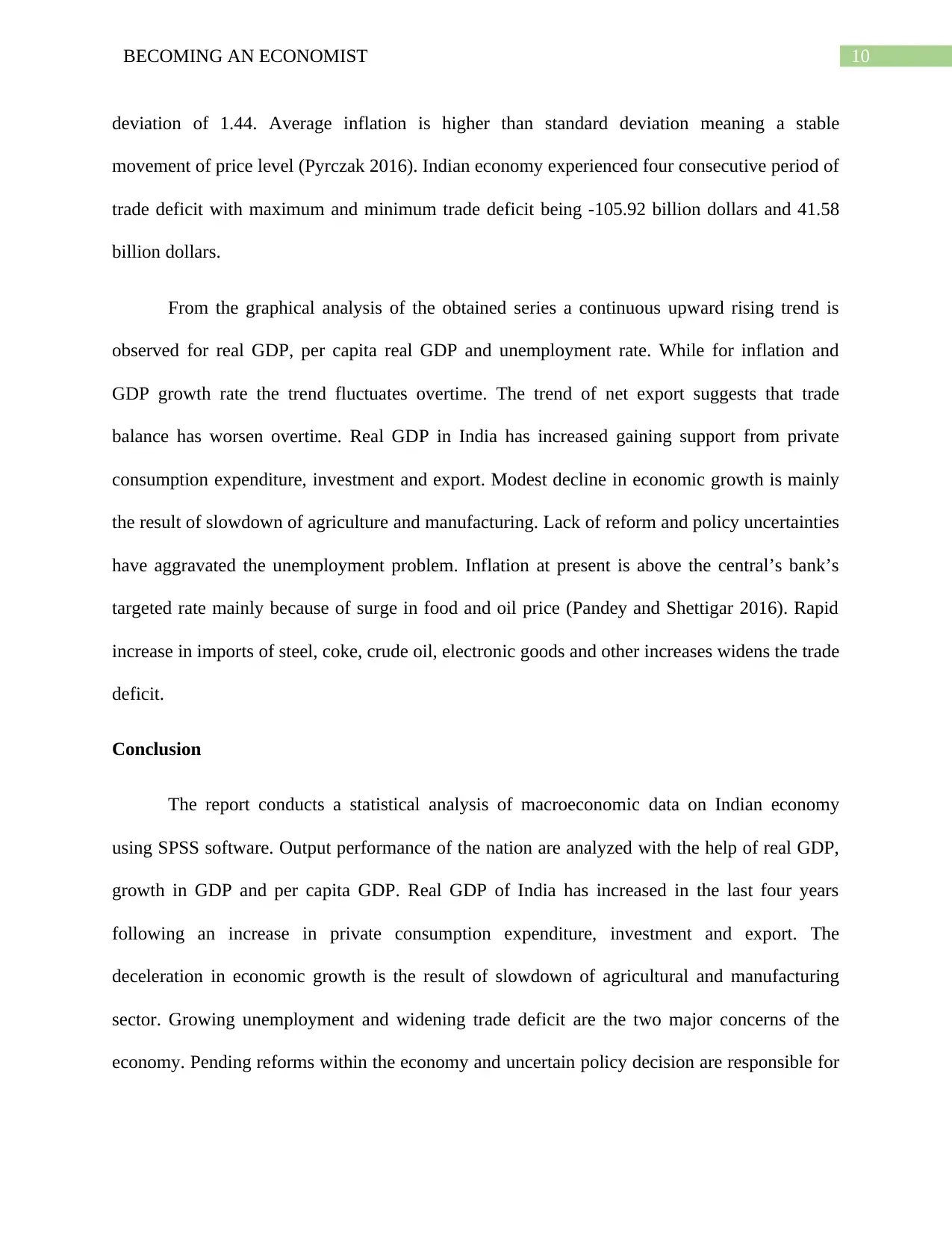
10BECOMING AN ECONOMIST
deviation of 1.44. Average inflation is higher than standard deviation meaning a stable
movement of price level (Pyrczak 2016). Indian economy experienced four consecutive period of
trade deficit with maximum and minimum trade deficit being -105.92 billion dollars and 41.58
billion dollars.
From the graphical analysis of the obtained series a continuous upward rising trend is
observed for real GDP, per capita real GDP and unemployment rate. While for inflation and
GDP growth rate the trend fluctuates overtime. The trend of net export suggests that trade
balance has worsen overtime. Real GDP in India has increased gaining support from private
consumption expenditure, investment and export. Modest decline in economic growth is mainly
the result of slowdown of agriculture and manufacturing. Lack of reform and policy uncertainties
have aggravated the unemployment problem. Inflation at present is above the central’s bank’s
targeted rate mainly because of surge in food and oil price (Pandey and Shettigar 2016). Rapid
increase in imports of steel, coke, crude oil, electronic goods and other increases widens the trade
deficit.
Conclusion
The report conducts a statistical analysis of macroeconomic data on Indian economy
using SPSS software. Output performance of the nation are analyzed with the help of real GDP,
growth in GDP and per capita GDP. Real GDP of India has increased in the last four years
following an increase in private consumption expenditure, investment and export. The
deceleration in economic growth is the result of slowdown of agricultural and manufacturing
sector. Growing unemployment and widening trade deficit are the two major concerns of the
economy. Pending reforms within the economy and uncertain policy decision are responsible for
deviation of 1.44. Average inflation is higher than standard deviation meaning a stable
movement of price level (Pyrczak 2016). Indian economy experienced four consecutive period of
trade deficit with maximum and minimum trade deficit being -105.92 billion dollars and 41.58
billion dollars.
From the graphical analysis of the obtained series a continuous upward rising trend is
observed for real GDP, per capita real GDP and unemployment rate. While for inflation and
GDP growth rate the trend fluctuates overtime. The trend of net export suggests that trade
balance has worsen overtime. Real GDP in India has increased gaining support from private
consumption expenditure, investment and export. Modest decline in economic growth is mainly
the result of slowdown of agriculture and manufacturing. Lack of reform and policy uncertainties
have aggravated the unemployment problem. Inflation at present is above the central’s bank’s
targeted rate mainly because of surge in food and oil price (Pandey and Shettigar 2016). Rapid
increase in imports of steel, coke, crude oil, electronic goods and other increases widens the trade
deficit.
Conclusion
The report conducts a statistical analysis of macroeconomic data on Indian economy
using SPSS software. Output performance of the nation are analyzed with the help of real GDP,
growth in GDP and per capita GDP. Real GDP of India has increased in the last four years
following an increase in private consumption expenditure, investment and export. The
deceleration in economic growth is the result of slowdown of agricultural and manufacturing
sector. Growing unemployment and widening trade deficit are the two major concerns of the
economy. Pending reforms within the economy and uncertain policy decision are responsible for
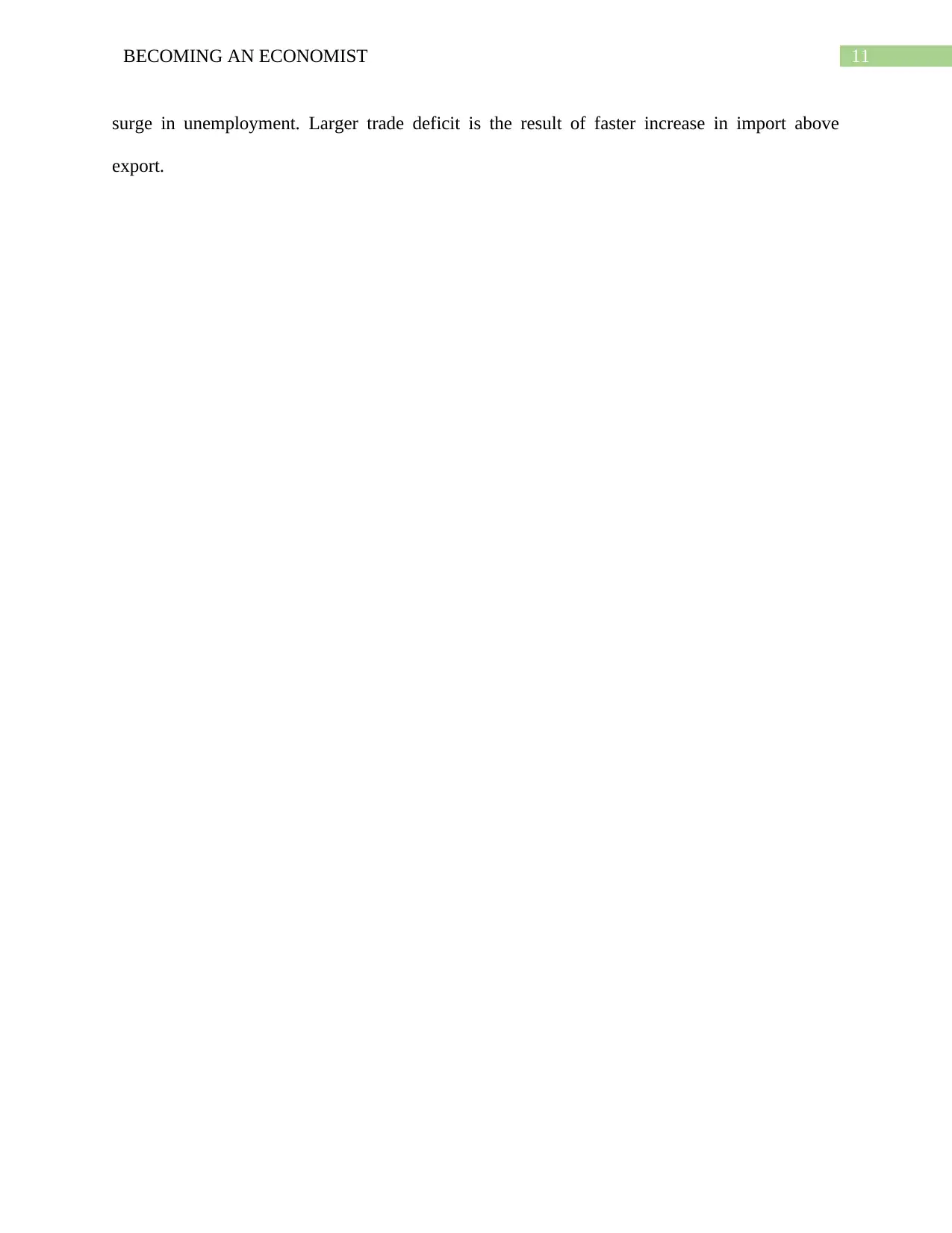
11BECOMING AN ECONOMIST
surge in unemployment. Larger trade deficit is the result of faster increase in import above
export.
surge in unemployment. Larger trade deficit is the result of faster increase in import above
export.
⊘ This is a preview!⊘
Do you want full access?
Subscribe today to unlock all pages.

Trusted by 1+ million students worldwide
1 out of 13
Related Documents
Your All-in-One AI-Powered Toolkit for Academic Success.
+13062052269
info@desklib.com
Available 24*7 on WhatsApp / Email
![[object Object]](/_next/static/media/star-bottom.7253800d.svg)
Unlock your academic potential
Copyright © 2020–2025 A2Z Services. All Rights Reserved. Developed and managed by ZUCOL.




